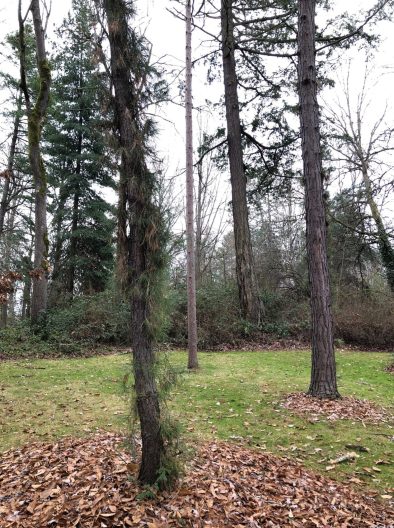January 2023 Plant Profile: Pitch Pine
Pinus rigida
Family: Pinaceae
Commonly called: Pitch Pine

What better time than winter to highlight one of the Arboretum’s conifer specimens? January is also an excellent time to take a trip out to Foster Island to walk amongst some of the many birds that make the Washington Park Arboretum home. Beside the path on Foster Island – just before you cross under the 520 bridge – you will find a pair of Pinus rigida. The species name rigida refers to its stiff and sharp cone scales and needles. The tree’s common name – pitch pine – derives from the high resin content in its wood.
Pitch pine is native to the Eastern United States and Southeast Canada and is hardy to Zone 4. Since it prefers shallow and sandy soils, native stands are most heavily concentrated in coastal areas such as Cape Cod or Long Island. It also thrives amongst the sand dunes along the shores of Lake Michigan.
Pitch pine’s needles are about 2.5 inches in length, and each fascicle holds three twisted needles. Its seed cones are reddish brown, and between 2 and 4 inches in length. It can reach up to 100 feet in height, and its reddish black, deeply furrowed bark and twisting branches give it a gnarled appearance. Further contributing to its weathered appearance is one characteristic that makes Pitch pine stand out from most other species in its family: its production of epicormic shoots.

The word epicormic derives from the Greek words ‘epi’ (meaning ‘near to’) and ‘kormos’ (meaning ‘log’ or ‘trunk’), and these shoots develop from dormant buds on a tree’s trunk or branches. When viewing pitch pine from even a short distance, it looks as though tufts of needles are sprouting directly from the tree’s trunk, all along its length. The northern most pitch pine on Foster Island, in particular, has quite the fuzzy appearance!
Like many other pines, pitch pine has varied ethnobotanical uses. Members of the Iroquois Tribe used the pitch for its anti-rheumatic, antiseptic, and laxative properties, and members of the Cherokee Tribe used it in carving both canoes and decorative objects. Due to its high resin content, pitch pine’s wood is less susceptible to rot than that of other pines, and its lumber was once in great demand for ship building and other construction projects. This high resin content also means that pitch pine’s wood is quite flammable and it was used heavily for firewood, which led to its less well known common name of ‘candlewood.’
Sources:
American Conifer Society
North Carolina Extension Gardener Plant Toolbox
Native American Ethnobotany Database